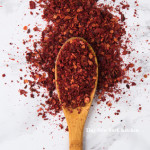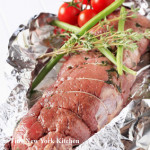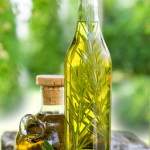The best way to be a good cook is not to worry about being a perfect cook. Give up on perfection, or at least any ideas you may have that perfection is a fixed thing against which you must measure everything you do. Nothing we cook will look will look exactly the same as a picture in a magazine or taste the way our friend’s dish did. Even a familiar recipe will not offer the same result from one day to the next time we make it.
We at Tiny New York Kitchen like to experiment with flavors. Often we reach into our well-stocked pantry and use the essential flavor builders to take a dish to the next level.
Essential Flavor Builders To Keep On Hand:
Vinegars: Vinegar’s complex tang is the secret ingredient in many recipes. We shake a bit of sherry vinegar into bean soup, and add rice vinegar to coleslaw dressings. If you had to choose just one vinegar, we would recommend the mild rice vinegar, but we also keep balsamic, sherry, malt, and cider vinegars on hand.
Anchovies: A filet of anchovy blended into a marinade or dressing adds savory flavor without being too overtly fishy.
Chili Paste: We keep chili paste or bottled Sriracha for drizzling over rice and adding to meat marinades.
Red Pepper Flakes: Many dishes get better with a little kick from red pepper flakes.
Soy Sauce: Soy sauce is a way to add umami flavor and a little salt to dressing and soups.
“Work With What You Got!”
©Tiny New York Kitchen © 2018 All Rights Reserved
Place room temperature eggs in a single layer in a saucepan and add enough cold water to cover by 1 inch. Add 1 tablespoon vinegar and 1/2 teaspoon salt to the water to help prevent the shells from cracking and the whites from running should the shells crack. Bring the water to a boil over a high heat. Once the water boils, turn off the heat, cover the pot, and let it stand for 10 minutes. Remove the eggs with a slotted spoon and gently place them in an ice bath.
Peel and use hard-boiled eggs or store the unpeeled eggs in a covered container in the refrigerator for up to 5 days.
“Work With What You Got!”
©Tiny New York Kitchen © 2018 All Rights Reserved
Grilling season is upon us and many want to grill fish, but have questions on the best way to do it. Here are some easy tips to help you get the most out of your fish grilling experience.
Ask Your Fishmonger. Fishmongers are knowledgeable and can recommend the best fish for dinner. They will clean your fish for you as well.
Take It Easy. Leave the fish head and tail on for easier handling, and try grilling a small 1 to 1 1/2 pound fish if you’re a first-timer.
Work With A Clean Grill. Scrub the grates clean with a wire brush to reduce sticking, and rub the exterior of the fish with oil before placing it on the grill.
Get Cooking And Don’t Be A Flipper. Grill over a medium-high heat for about 8 minutes total cooking time per inch of thickness. Most fish will cook best if turned only once, so wait at least 3 minutes for the fish to form a crust on the outside before flipping. Don’t risk the fish falling apart by trying to flip multiple times.
“Work With What You Got!”
©Tiny New York Kitchen © 2018 All Rights Reserved
Going out for dinner on Valentine’s Day is a risky affair. Even the best restaurants can have “overload difficulties” on such a busy night where couples have expectations of restaurant perfection. A better way to manage expectations is to take control of them yourself. Food is a language of love. You know what you like and what your loved one likes. No need to worry about cheesy love songs or a perfumed soaked lady sitting next to you. Nothing says I love you more than taking the time to make a special meal for the person you love. Visit the local farmers’ market, butcher, or seafood shop to buy their favorite seasonal ingredients. Come up with a meal that celebrates love. Turn off the lights, fire up all the candles and put on your favorite music.
Keep it easy and made make it special. Plan out the meal from beginning to end to get organized and make sure you have a solid menu. If you’re not a seasoned cook make sure to keep it simple and I recommend not trying to make complicated dishes that you’ve never made before. Make it easy with three courses. Begin with a beautiful cheese plate. Embrace easy, big impact dishes. Start off with prosciutto-wrapped scallops finished with a squeeze of lemon. Warm things up with braised short ribs or steaks finished off with butter and herbs. Keep desserts simple, but sweet. Decorate bakery cakes with fresh fruit or edible flowers or warm up slices of pie and top with caramel sauce and a gourmet ice cream or try your hand at an easy dessert of chocolate pots de crème. Don’t forget that nice bottle of wine or champagne.
“Work With What You Got!”
©Tiny New York Kitchen © 2018 All Rights Reserved
Standing Beef Rib Roast
How Much To Buy: A 54 to 5 Pound Roast Serves 8 to 10
Keep meat at room temperature for an hour or so. Preheat oven to 450 degrees. Rub roast with lots of olive oil, cracked peppercorns, minced garlic, kosher salt, and 2 tablespoons of an herb or spice rub, if desired. Place roast meat-side down in a roasting pan and cook 30 minutes. Reduce heat to 425 degrees. Continue roasting for about 3 minutes per pound. Turn oven back up to 450 degrees and roast another 15 minutes, or until meat thermometer reaches 125 degrees for rare, 140 degrees for medium-rare or 160 degrees for well-done. Remove from oven and let rest 15 minutes. Skin fat from juices, and pour some dry red wine into the pan with the drippings. Over a low heat, stir wine, scraping up any browned bits on bottom of pan. Serve over roast as a sauce.
Roasted Beef Tenderloin
How Much To Buy: A 4 to 5 Pound Tenderloin Serves 8
Position oven rack in center. Preheat oven to 425 degrees. Lightly oil a roasting pan. Mix 2 tablespoons olive oil, 1 tablespoon minced garlic, 2 teaspoons each of rosemary and thyme, and kosher salt and freshly ground pepper to taste. Rub over entire surface of meat. Place meat into roasting pan and cook until thermometer inserted into thickest part of the roast reads 125 degrees for rare, 140 degrees for medium-rare or 160 degrees for well-done. This should take 35 to 55 minutes. You may baste with pan juices halfway through cooking, if desired. Remove from oven. Let rest 15 minutes and serve.
“Work With What You Got!”
© Victoria Hart Glavin Tiny New York Kitchen © 2017 All Rights Reserved
Steaming eggs is the secret to hard-boiled eggs that are consistently perfect.
Don’t place an egg in boiling water. That lowers the temperature of the water and makes it hard to nail down a precise cooking time.
Do steam in a steamer basket. The eggs don’t touch the water, which means they don’t lower the water temperature, so you get consistently perfect results.
Bring 1 inch water to rolling boil in medium-size saucepan over a high heat. Place eggs in steamer basket. Transfer basket to saucepan. Cover, reduce heat to a medium-low and cook eggs for 13 minutes. When eggs are almost finished cooking, combine 2 cups ice cubes and 2 cups cold water in medium-size bowl. Use tongs or spoon to transfer eggs to ice bath. Let sit for 15 minutes. Peel before using.
“Work With What You Got!”
© Victoria Hart Glavin Tiny New York Kitchen © 2017 All Rights Reserved
The end of summer is fresh produce heaven, which includes delicious vine ripened tomatoes. What do you do when you have a tomato abundance?
Here are some tips for making the most of the end of summer tomatoes.
Sliced: Incorporate into sandwiches or add to basil and mozzarella for a Caprese Salad.
Chopped: You only need a few chopped heirloom tomatoes, mozzarella, chopped basil, and olive oil for a colorful no-cook pasta sauce.
Puréed: There’s nothing like an icy cold gazpacho on a warm day.
Salsa: Fresh salsa is a must have condiment for grilled steaks or shrimp, brown rice and beans, scrambled eggs, and of course, chips.
Grilled: Toss cherry tomatoes with olive oil, garlic, and herbs. Then cook in a grill basket until charred. Top fish, chicken, pasta, and charred slices of bread.
Stored: Keep tomatoes at room temperature until ripe and then use within a day or two. Don’t put them in the refrigerator as it affects their flavor and texture.
Preserved: Roasted, dehydrated, or stewed – savor the season by saving a taste of summer for later.
“Work With What You Got!”
© Victoria Hart Glavin Tiny New York Kitchen © 2017 All Rights Reserved
One of the best ways to preserve the abundance of fresh herbs from your garden is by making flavored oils. Herb oils can be enjoyed so many ways – drizzled over salads, vegetables, pastas, sandwiches, or grilled items, hot or cold or at room temperature. Not only are they flavorful, but they also add dramatic color when drizzled on plates. If you want to add more flavor add half a clove of smashed garlic and 1/2 teaspoon crushed red pepper to the blender with the other ingredients, which makes a great dipping oil for chunks of rustic bread.
“Work With What You Got!”
© Victoria Hart Glavin Tiny New York Kitchen © 2017 All Rights Reserved
There are almost as many varieties of pears as there are apples, but only a dozen or so are readily available in stores. Pears are related to apples, but are much more fragile and are more often eaten raw than cooked. They have fine white granular flesh and a core containing the pips (seeds). Most pears are wider at the bottom than the top, but some are apple-shaped, while calabash pears have an elongated neck, like a gourd. Pears tend to be less vividly colored than apples, usually varying from bronze to gold, green or yellow, although there are also some red-bushed varieties such as Red Williams and Forelle.
Anjou: These large pears have greenish yellow skin with small brown spots. The flesh is juicy and sweet. Suitable for eating and cooking.
Beurre Superfin: Large, with a tough golden green, russet skin, this is the perfect eating pear. Its flesh is sweet and juicy and it is less grainy than other pears.
Conference: First cultivated in the English country of Berkshire in 1770, these long, conical pears have remained a favorite because they keep so well. The yellowish-green skin with extensive russet turns more yellow when the pears are mature. The granular flesh is tender, sweet and juicy. Conference pears are excellent for eating and cooking.
Comice: This large, roundish pear is one of the finest of all pears, with creamy white, melting, very juicy flesh and a sweet, aromatic flavor. The thick, yellowish-green skin is covered with speckles and patches of russet. Comice are best eaten raw and they are delicious served with Camembert or Brie cheese.
Forelle: This beautiful golden pear has a dark red flush on one side. The grainy flesh is crisp, with a fresh flavor. Eaten raw, it goes particularly well with cheese, but is at its best when cooked.
Laxton’s Foremost: Yellow-skinned and lightly russet, this is one of the largest pears. Its creamy colored flesh is very juicy and granular. It does not keep well and, as it turns brown from the inside out, there may be no external signs that the fruit is past its best.
Packham’s Triumph: The first successful Australian pear was produced by Charles Packham in 1896 and remains a favorite. Slow-ripening, it is a largish dessert pear, with a smooth green, lightly russet skin that changes to yellow as it ripens. The soft white flesh is succulent and sweet, with a touch of acidity.
Red Williams: These pears have shiny, speckled skins, at first green with a red blush, turning to yellow flushed with red. The flesh is sweet and juicy.
Bartlett/Williams Bon Chrétien: These irregularly shaped pears are generally swollen on one side of the stalk. The speckled skin is golden yellow with russet patches and sometimes a red tinge. The delicious tender flesh is creamy-white and very juicy, and the flavor is sweet and slightly musky. Bartletts are suitable for cooking and eating, but unfortunately these superb pears do not keep well.
Winter Nelis: This roundish medium-size pear has thick, but tender greenish-yellow skin with cinnamon-brown russet and sometimes a pink flush. The creamy-white flesh is soft and very juicy, and the flavor is sweet. These pears can be cooked or eaten raw.
Perry Pears: With the demise of the most famous of the sparkling alcoholic pear drinks, perry pears have largely fallen into disfavor. A few small producers still press perry pears into juice, wine or “champagne” perry, but although there are still about 300 known varieties, you will never find these in stores. Perry pears are smaller than their dessert counterparts. Although they look delicious, they contain large quantities of tannin and taste bitter and astringent, whether raw or cooked.
Asian/Nashi Pears: There are many varieties of Asian pears, but their characteristics are very similar. They are round rather than a pear shape, the fruits have a golden brown russet skin and they have very crisp, white juicy flesh. The crunchy texture resembles that of an apple, but is more granular. It would be a shame to spoil the crisp texture by cooking. Asian pears are best eaten straight from the refrigerator, to be enjoyed as a “drink of the stalk”. They also make an excellent addition to fruit salads or savory winter salads.
Tientsin: These Asian pears from China and Korea are very similar to Asian Nashi pears in taste and texture. They are available when Asian pears are out of season. They look rather like elongated apples, tapering gently at both ends. The skin is pale yellow, slightly speckled with patches of light brown. The pure white flesh is exceptionally juicy and crunchy.
Hosui: These pears have much the same crunch and juiciness of the Tientsin pears, but look more like apples, with green-brown mottled flesh that tastes like a cross between an apple and an unripe pear.
Buying and Storing: Always buy pears when in perfect condition, as they deteriorate quickly. Once past their best, they become wooly and squashy and unpleasant. Test for ripeness by pressing gently; the fruit should give a little, but still be quite firm. Once ripe, eat within a couple of days. They can be kept at the bottom of the refrigerator for a few days. Store unripened pears at room temperature, where they will ripen in two or three days.
Preparing and Cooking: The majority of pears are eaten raw, by themselves or with a robust cheese such a Stilton or Roquefort. Pears Savarin, halved fruit filled with Roquefort mashed with a little butter are served chilled with double (heavy) cream and paprika, is a popular appetizer. Pears also make a good addition to winter salads. Whether or not to peel pears before eating raw is a matter of preference, but they should always be peeled before cooking. Pears discolor quickly once they are peeled, so rub the cut surface with lemon juice or place in a bowl of water acidulated with lemon juice. If the recipe involves cooking the pears in wine or sugar syrup, the fruit can be put directly into these to prevent them turning brown.
Most varieties of pears are suitable for cooking, but some are specifically designated cooking pears, although commercial production of these is now decreasing. If appearance is important, choose even-size, classic pear-shaped pears such as Comice, Conference or Bartlett. For whole poached pears, simply peel with a stainless steel vegetable peeler, leaving the stalk on. Use an apple corer to core the pears if you want to stuff them with nuts or dried fruit. Poach in port or red wine spiced with cinnamon, cloves and thinly pared lemon rind, or in a vanilla-flavored syrup. For sautéed or grilled (broiled) pears, peel and quarter the fruit and scoop out the cores with a melon baller. Sauté over a low heat in unsalted butter or grill (broil), turning once, watching very closely to avoid the fruit scorching.
Pears can be used in a wide variety of desserts, including tarts, mousses, soufflés, sorbets, and ice creams. They are also delicious grated into tea breads. Pears go particularly well with nuts, especially walnuts and almonds, in both sweet tarts and savory winter salads.
Like apples, pears complement game, particularly duck and hare, while venison garnished with pears is a German specialty. For additional luxury, the pears may be cooked in pear brandy, also known as Williamine, or pear liqueur. Pears can also be roasted with small game birds and then rubbed through a sieve and served as a sauce. A slightly more unusual, but delicious combination is lamb and pears, slow cooked in a casserole. Pears also feature in soups, most famously with watercress and also with garden peas.
Fruit vinegars have come back into fashion and steeping pears in vinegar to flavor it has a long history in country and farmhouse cooking. The vinegar is a rich golden color. It can be used in salad dressings, as part of a basting mixture when roasting rich meats, especially duck, or for deglazing the cooking juices after pan-frying liver or duck to make a sauce. Pear chutney is also a traditional rural favorite, not least because you can use hard, windfall pears that would otherwise have to be thrown away. Pears can also be steeped in brandy for several weeks to make a liqueur for drinking after dinner. A more modern variation of this is to steep the fruit in vodka.
“Work With What You Got!”
© Victoria Hart Glavin Tiny New York Kitchen © 2017 All Rights Reserved
Grilled pineapple is so very versatile because you can use it for savory or sweet, hot or cold dishes. Grill over indirect heat and the sugars in the pineapple concentrate bringing out a sweet and meaty fruit that is ideal for endless summer recipes.
6 Ways To Use Grilled Pineapple
Slice and serve with grilled pork or fish.
Cut into chunks and toss with salt and lime juice for a smoky fruit salad.
Muddle and use as the base for a sweet-savory cocktail.
Dice and mix with chopped cilantro and chiles for salsa.
Purée and spoon over vanilla ice cream or good Greek yogurt.
Top with ice cream or sorbet.
“Work With What You Got!”
© Victoria Hart Glavin Tiny New York Kitchen © 2017 All Rights Reserved















